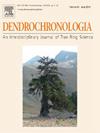Recording chemical changes in an urban environment: A dendrochemical study of Ceiba speciosa (A. St.-Hil.) Ravenna (Malvaceae) in the Atlantic Forest
IF 2.7
3区 农林科学
Q1 FORESTRY
引用次数: 0
Abstract
Trees are capable of recording in their wood the environmental conditions they experience, earning them recognition as environmental archives. Dendrochemistry relates wood chemistry to environmental chemistry and internal biological processes that influence the absorption and incorporation of chemical elements into growth rings. We evaluated the annual concentrations of chemical elements fixed in the wood of Ceiba speciosa (A. St.-Hil.) Ravenna (Malvaceae) at two Atlantic Forest locations, representing low and high urbanization, in the city of Rio de Janeiro, Brazil. The samples used had been dated in a previous dendrochronological study and each growth ring was subjected to energy dispersive X-ray fluorescence (EDXRF). Eleven chemical elements were detected in the growth rings of Ceiba speciosa at both study sites. Concentrations varied among evaluated years and between sites, showing a positive relationship between concentrations accumulated in wood and concentrations present in the soil where the plants develop. The levels of potentially toxic elements in the wood increased significantly at the urban site, mainly since the end of the 1980s. The increase in the concentration of potentially toxic chemical elements in the xylem due to urbanization is a process little discussed for tropical species. In this sense, the dendrochemical study of Ceiba speciosa in the city of Rio de Janeiro represents an important historical environmental report for the Atlantic Forest. The present results, combined with those obtained previously in relation to cambial activity and wood anatomy and tree growth rates of wood and trees in urban environments, indicate that Ceiba speciosa has potential as an important biomarker in environmental monitoring studies.
记录城市环境中的化学变化:木棉树化学研究(A. st . hill .)大西洋森林中的拉文纳(锦葵科)
树木能够在它们的木材中记录它们所经历的环境条件,使它们成为环境档案。树木化学将木材化学与环境化学和影响化学元素进入生长环的内部生物过程联系起来。测定了木棉(Ceiba speciosa, A. st . hill .)木材中固定化学元素的年浓度。巴西里约热内卢市两个大西洋森林地点的拉文纳(Malvaceae),代表低城市化和高城市化。所使用的样品在之前的树木年代学研究中已经确定了年代,每个生长环都经过能量色散x射线荧光(EDXRF)检测。在两个研究地点的竹叶生长环中均检测到11种化学元素。在评估年份和地点之间,浓度有所不同,表明木材中积累的浓度与植物生长的土壤中存在的浓度呈正相关。主要是自1980年代末以来,城市地区木材中潜在有毒元素的含量显著增加。城市化导致木质部中潜在有毒化学元素浓度的增加,这一过程在热带物种中很少被讨论。从这个意义上说,巴西里约热内卢市Ceiba speciosa的树木化学研究代表了大西洋森林的重要历史环境报告。本研究结果,结合以往有关城市环境中木材和树木形成层活性、木材解剖和树木生长速率的研究结果,表明Ceiba speciosa具有作为环境监测研究中重要的生物标志物的潜力。
本文章由计算机程序翻译,如有差异,请以英文原文为准。
求助全文
约1分钟内获得全文
求助全文
来源期刊

Dendrochronologia
FORESTRY-GEOGRAPHY, PHYSICAL
CiteScore
5.50
自引率
13.30%
发文量
82
审稿时长
22.8 weeks
期刊介绍:
Dendrochronologia is a peer-reviewed international scholarly journal that presents high-quality research related to growth rings of woody plants, i.e., trees and shrubs, and the application of tree-ring studies.
The areas covered by the journal include, but are not limited to:
Archaeology
Botany
Climatology
Ecology
Forestry
Geology
Hydrology
Original research articles, reviews, communications, technical notes and personal notes are considered for publication.
 求助内容:
求助内容: 应助结果提醒方式:
应助结果提醒方式:


